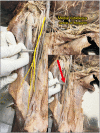Uncommon configuration of intercostobrachial nerves, lateral roots, and absent medial cutaneous nerve of arm in a cadaveric study
- PMID: 37798844
- PMCID: PMC10714078
- DOI: 10.5115/acb.23.149
Uncommon configuration of intercostobrachial nerves, lateral roots, and absent medial cutaneous nerve of arm in a cadaveric study
Abstract
The intercostobrachial nerve (ICBN) originates from the second intercostal nerve's lateral cutaneous branch, while the median nerve (MN) typically arises from the brachial plexus's lateral and medial roots. The medial cutaneous nerve of the arm, a branch of the medial cord of the brachial plexus, often connects with the ICBN. Variations were observed during the dissection of a 50-year-old male cadaver, including MN having two lateral roots (LR), LR1 and LR2, joining at different levels. Three ICBNs innervated the arm in this case, with the absence of the medial cutaneous nerve of the arm compensated by branches from the medial cutaneous nerve of the forearm. Understanding these anatomical variations is crucial for surgical procedures like brachioplasty, breast augmentation, axillary lymph node dissection, and orthopedic surgery. Surgeons and medical professionals must be aware of these variations to enhance preoperative planning, minimize complications, and improve patient outcomes in these procedures.
Keywords: Anatomical variation; Axillary artery; Brachial plexus; Median nerve; Upper limb surgery.
Conflict of interest statement
No potential conflict of interest relevant to this article was reported.
Figures



References
-
- Jyoti, Sharma A. Brachial plexus: variations in infraclavicular part and their significance. Int J Sci Study. 2020;8:9–13.
-
- Moore KL, Dalley AF, Agur AMR. Clinically oriented anatomy. 6th ed. Wolters Kluwer Health/Lippincott Williams & Wilkins; 2010. - DOI
-
- Koshi R, Cunningham DJ. Cunningham's manual of practical anatomy. 16th ed. Oxford University Press; 2017. - DOI
Publication types
LinkOut - more resources
Full Text Sources
